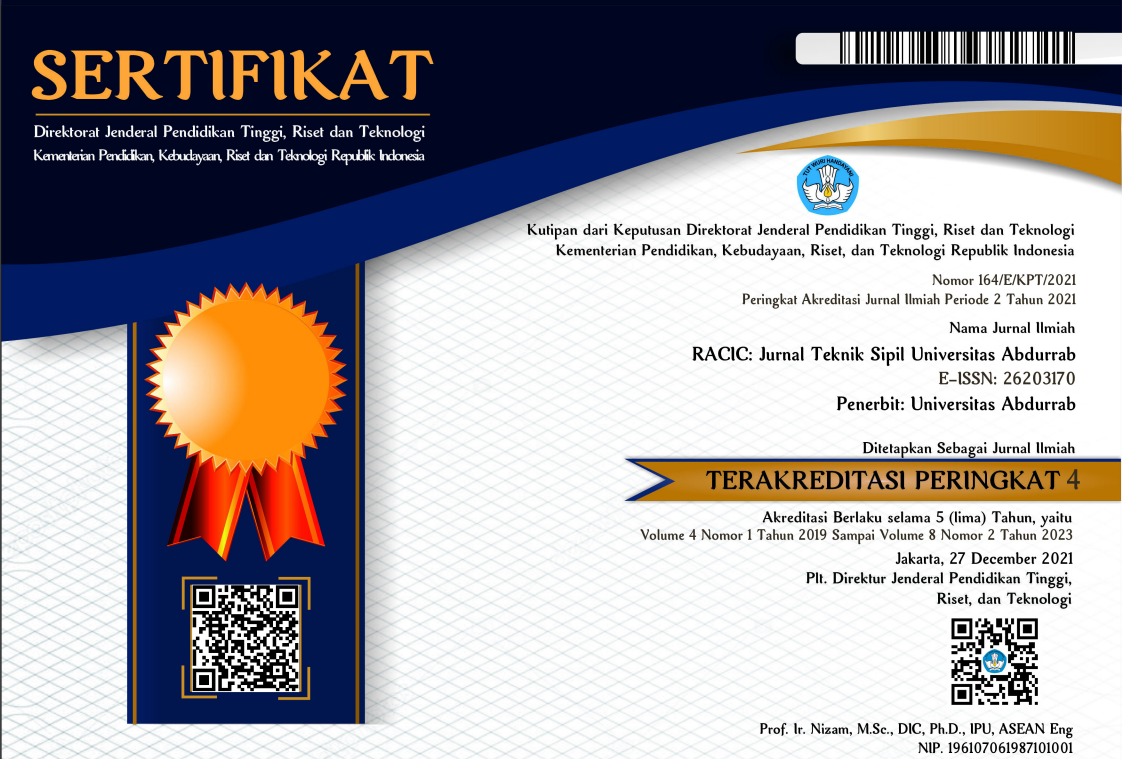PREDIKSI KAPASITAS PENAMPANG KOLOM BETON BERTULANG DENGAN VARIASI DIAMETER TULANGAN
DOI:
https://doi.org/10.36341/racic.v7i1.2401Keywords:
android, column, RCC Column DesignAbstract
Reinforced concrete column design is the process of determining the dimensions of the columns and reinforcement required with the appropriate quality of concrete and steel so that they can withstand the planned load to work on the column. Unlike the beam design, which was based on the applied load, it is possible to determine the cross-sectional dimensions and reinforcement requirements directly from the design equation, and the column design process is iterative. A column generally experiences axial forces, shear forces, bending moments, and torsional moments. In this paper, cross-sections of reinforced concrete columns are modelled and analyzed using an android application that can be installed via the play store. The application offered by eigenplus named RCC Column Design version 2.1.12 was released on 17 September 2017. The last updated RCC Column Design application was on 25 March 2018. This paper aims to predict the cross-sectional capacity of reinforced concrete columns with variations in reinforcement diameter. The cross-sectional capacity of the column referred to in this paper is the axial capacity, moment capacity, and shear capacity. Furthermore, the value of the cross-sectional capacity of reinforced concrete columns with variations in the diameter of the reinforcement has been obtained. The values ​​obtained are proposed as predictions in this paper.
Downloads
References
[2] A. H. Nilson, Design of concrete structures, 10th ed. New York: NY: McGw-Hill book Company, 2004.
[3] R. Green, “Reinforced Concrete Column Design,†in Trends in Structural Mechanics, 1997.
[4] M. Anwar, N., & Qaasim, “Parametric study of reinforced concrete column cross-section for strength and ductility,†Key Eng. Mater., 2009, doi: 10.4028/www.scientific.net/kem.400-402.269.
[5] M. S. Al-ansari, M.S., & Afzal, “Simplified biaxial column interaction charts,†Eng. Reports, no. November, pp. 1–15, 2019, doi: 10.1002/eng2.12076.
[6] M. S. Al-Ansari, M.S., & Afzal, “Simplified irregular column analysis by equivalent square method,†J. Struct. Eng. Appl. Mech., vol. 2, no. 1, pp. 36–46, 2019, doi: 10.31462/jseam.2019.01036046.
[7] A. B. Al-Ansari, M.S., & Senouci, “Use of Mathcad as a Teaching and Learning Tool for Reinforced Concrete Design of Footings,†Int. J. Engng Ed, vol. 15, no. 1, pp. 64–71, 1999, doi: 10.1002/(SICI)1099-0542(1999)7:3<146::AID-CAE2>3.0.CO;2-8.
[8] M. S. Al-Ansari and A. B. Senouci, “MATHCAD: Teaching and Learning Tool for Reinforced Concrete Design,†IOSR J. Eng., vol. 9, no. 2, pp. 43–52, 2019.
[9] M. S. Al-Ansari, M.S., & Afzal, “Mathematical model for analysis of uniaxial and biaxial reinforced concrete columns,†Hindawi Adv. Civ. Eng., p. 13 pages, 2020, doi: 10.1155/2020/8868481.
[10] Karabins, A.I., & Kiousis, P.D., “Strength and Ductility of Rectangular Concrete Columns: A Plasticity Approach,†J. Struct. Eng., pp. 1693-1267–274694, 1996, doi: 10.1061/(asce)0733-9445(1997)123:12(1693).
[11] A. Ivanov, “Special features for the design of slender columns in monolithic multistory buildings with the consideration of longitudinal bending,†J. Concr. Reinf. Concr., vol. 5, pp. 27–29, 2004.
[12] C. Dundar, “Concrete Box Sections under Biaxial Bending and Axial Load,†J. Struct. Eng., pp. 860–865, 1990, doi: 10.1061/(asce)0733-9445(1990)116:3(860).
[13] S. E. Afefy, H.M., Taher, S.F., & El Metwally, “A new design procedure for braced reinforced high strength concrete columns under uniaxial and biaxial compression,†Arab. J. Sci. Eng., pp. 349–377, 2009.
[14] F. A. C. Passos, G.L.S., Tasinaffo, R.I., Cordeiro, S.G.F., & Monteiro, “Computation of Axial Forces-Bending Moments Interaction Diagrams for Reinforced Concrete Polygonal Cross Sections,†in Proceedings of the XLI Ibero-Latin-American Congress on Computational Methods in Engineering, ABMEC, 2020, no. November.
[15] S. Aikhtonbare, N.L., Mansour, M.Y., & Kalaga, “Behavior of Defective RCC Columns,†indian Concr. J., no. December 1999, pp. 1–5, 1999.
[16] Meenu, K., “RCC Column Design v 2.1.12.†eigenplus, 2018.
Downloads
Published
Issue
Section
License
1. Copyright of all journal manuscripts is held by the RACIC : Rab Construction Research
2. Formal legal provisions to access digital articles of electronic journal are subject to the provision of the Creative Commons Attribution-ShareAlike license (CC BY-NC-SA), which means that RACIC : Rab Construction Research is rightful to keep, transfer media/format, manage in the form of databases, maintain, and publish articles.
3. Published manuscripts both printed and electronic are open access for educational, research, and library purposes. Additionally, the editorial board is not responsible for any violations of copyright law.
licensed under a Creative Commons Attribution-ShareAlike 4.0 International License.





